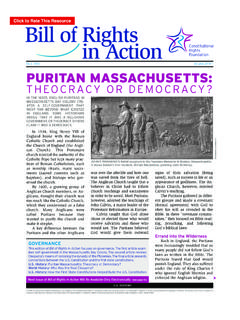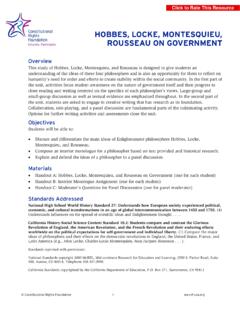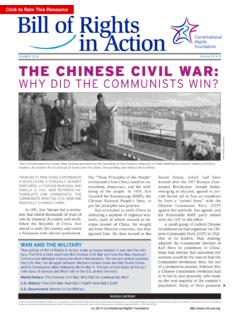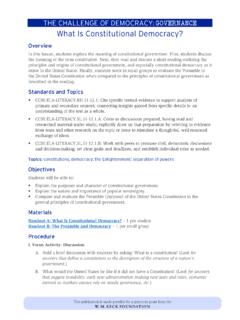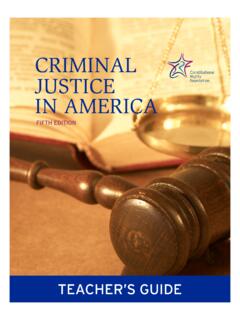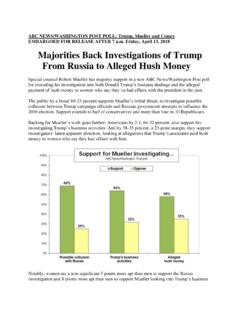Transcription of The Marshall Plan for Rebuilding Western Europe
1 1 Constitutional Rights Foundation ( ) | The Marshall plan for Rebuilding Western Europe 1 HR The Marshall plan was a series of economic strategies and reforms that helped to strengthen Western Europe after World War II. It also helped to make the United States the leader of the free world. During World War II, the United States and the Soviet Union fought together as allies against Nazi Germany. When the war ended, Soviet troops occupied much of Eastern and Central Europe . Communist governments, allied with the Soviet Union, soon controlled this area and set up police states. In 1946, Winston Churchill, who had served as British prime minister during the war, famously warned that an iron curtain divided Western and Eastern Europe and that communism threatened to spread throughout war-ravaged Europe .
2 The wartime alliance between the Soviet Union and the United States was ending. A new period of conflict between the two powers known as the Cold War was beginning. In January 1947, President Harry S. Truman appointed a new secretary of state George C. Marshall . Marshall was a career military officer and had headed the Army during World War II. As the leader of the Army, Marshall had earned the admiration of the American public. Soon after Marshall took office, a crisis arose over Greece. Greece had been occupied by Nazis during the war. Two resistance groups had fought the Nazis. One supported the Greek monarchy. The other was communist.
3 After liberation from the Nazis, the communists refused to join a new government and R ebelled against the monarchy. British troops put down the rebellion. In 1946, a new rebellion erupted. In February 1947, t h e British announced that they could no longer afford to give military and financial support to Greece. Based on what had happened in Eastern Europe , many in the government suspected that the Soviet Union was funding the communist rebels. (Most historians have since concluded that the Soviet Union, weakened by the war, gave little support to the rebels.) The Marshall plan for Rebuilding Western Europe Pedestrians walk past bomb-damaged buildings in London, England.
4 (National Archives) 2 Constitutional Rights Foundation ( ) | The Marshall plan for Rebuilding Western Europe 2 Marshall realized that only the United States was economically able to provide aid to Greece. The war had devastated the economies of other nations. At a key meeting in the White House, President Truman, Secretary of State Marshall , congressional leaders, and a few others debated what the United States should do about Greece. Marshall s assistant Dean Acheson warned that this crisis was just the beginning. If the communists were not stopped, he said, Soviet domination might extend to Europe , the Middle East, and Asia. On March 12, 1947, President Truman addressed Congress and asked for $400 million in economic aid for Greece and its neighbor Turkey.
5 He announced what came to known as the Truman Doctrine: I believe that it must be the policy of the United States to support free peoples who are resisting attempted subjugation by armed minorities or by outside pressure. Truman had in mind mainly economic aid to eliminate misery and want that often became the seeds of totalitarian regimes. Some criticized this new doctrine as too aggressive and likely to lead the United States into a costly reckless adventure. Within two months, however, the fear of a communist power grab in Greece prompted Congress to approve Truman s request for aid. The Idea of the Marshall plan In 1946, George F.
6 Kennan, a State Department Russian specialist, wrote a long telegram from Moscow analyzing Soviet intentions in Europe . The following year, Foreign Affairs magazine published the telegram as an article by X. The article caused a stir and was widely discussed. Kennan concluded that the Soviets, surrounded by capitalist countries, were insecure and wanted to expand their power. Kennan called for a long-term, patient but firm and vigilant containment of Russian expansive tendencies. Secretary of State Marshall appointed Kennan to head a planning group to assess whether European nations could resist Soviet expansion. Kennan quickly reported that the war had left Europe in terrible economic shape.
7 He reported on the grim realities in Europe : Many survivors of the war were homeless, hungry, and unemployed. Inflation robbed the wages of those who were employed. Factories, railroads, bridges, electric power plants, and water systems were damaged or destroyed. Farmers suffered from drought and when they brought their products to market, city dwellers could not afford them. Trade and the flow of capital needed to finance reconstruction were interrupted. Kennan recommended that the United States help rebuild the economic health and vigor of European society. He saw this not just as humanitarian aid, but as the best way to fight communism in Europe .
8 He believed that the European nations receiving aid needed to operate as an economic unit, much like the 13 colonies did after the American Revolution. Eventually, he argued, a rebuilt Europe would benefit the United States by once again being able to buy American factory and farm products. More importantly, an economically strong Europe would stop the spread of communism. Only a few weeks after President Truman requested aid for Greece and Turkey, Kennan and other top advisors to Secretary of State Marshall convinced him of the need for a massive aid program for all of Europe . On June 5, 1947, Secretary of State Marshall made an innovative proposal in a speech at Harvard University.
9 Noting the disastrous conditions in Europe , Marshall called for a joint effort by the European nations to plan the Rebuilding of Europe . The United States would provide friendly aid in drafting the plan , but this was really the business of the Europeans. President Truman (right) shakes hand with George C. Marshall shortlyafter Marshall is sworn in as secretary of state. (NationalArchives) 3 Constitutional Rights Foundation ( ) | The Marshall plan for Rebuilding Western Europe 3 Marshall promised that once the plan was in place, the United States would provide the necessary funds to make it work. Our policy, Marshall made clear, is directed not against any country or doctrine but against hunger, poverty, desperation, and chaos.
10 Making the Marshall plan Marshall even invited the Soviets to participate. But Kennan predicted that the Soviet Union and Eastern European countries under its control would refuse to join. He believed that Stalin, the Soviet dictator, would never go along with an American-inspired plan that required the free exchange of economic information. As predicted, the Soviets refused Marshall s invitation to help develop a plan to rebuild Europe . They charged that his plan was a scheme to dominate Europe economically. Under Soviet control, the Eastern European nations also declined to participate. In July 1947, 16 Western European nations met in Paris to put together an economic recovery plan .

